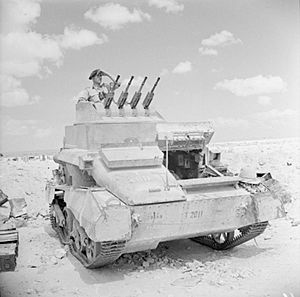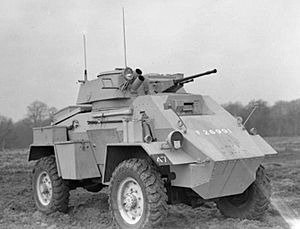Besa machine gun facts for kids
Quick facts for kids Besa machine gun |
|
|---|---|
| Type | Tank-mounted medium machine gun |
| Place of origin | Czechoslovakia, United Kingdom |
| Service history | |
| In service | 1939–1960s |
| Used by | United Kingdom, Ireland, Israel |
| Wars | Second World War 1947–1949 Palestine war Korean War Second Arab–Israeli War Lebanese Civil War |
| Production history | |
| Designer | Václav Holek |
| Designed | 1936 |
| Manufacturer | The Birmingham Small Arms Company Limited |
| Produced | 1939–1945 |
| No. built | 7.92mm: 39,332 in all variants. 15mm: 3,218 total production |
| Variants | Mark I (1939–1940) Mark II (1940–1943) Mark II*(1943) Mark III (1943–1951) Mark III* (1943–1952) Mark III/2 (1952–1966) Mark III/3 (1954–1966) 15mm Besa Mark I (1939?–1949) |
| Specifications | |
| Mass | 47 lb (21 kg) empty |
| Length | 43.5 in (1,100 mm) |
| Barrel length | 29 in (740 mm), 4-groove rifling with right-hand twist |
|
|
|
| Cartridge | 7.92×57mm Mauser |
| Calibre | 7.9mm |
| Action | gas automatic |
| Rate of fire | 450–550 round/min (Low) 750–850 rounds/min (High) |
| Muzzle velocity | 2,700 ft/s (823 m/s) |
| Feed system | 7.92mm: 225 metal link belt. 15mm: 25-round link belt |
The Besa machine gun was a powerful weapon used by the British military. It was a British version of a machine gun from Czechoslovakia, originally called the ZB-53. This gun was cooled by air and fed by a belt of ammunition.
The name "Besa" came from the Birmingham Small Arms Company (BSA). This company made a deal to build the gun in the United Kingdom. The British military ordered the weapon in 1938. Production started in 1939 after some changes were made to the design.
The Besa machine gun was widely used by the United Kingdom during the Second World War. It was mainly mounted on tanks and other armored vehicles. It replaced the older, heavier Vickers machine gun. Even though it needed a large opening in the tank's armor, it was a very dependable weapon.
Contents
How the Besa Gun Was Developed and Used
British forces usually used a specific type of ammunition called the .303 inch round. However, the original ZB-53 gun was designed for a German ammunition type, the 7.92mm Mauser round. The British decided to keep the 7.92mm size for the Besa gun. This was because changing the design to use the .303 round would have taken too long. A war was about to start, and they needed guns quickly. Also, the supply chain for tank ammunition was already separate from other army weapons.
The .303 version of the ZB-53 was tested in 1937 and performed very well. But due to the urgent need for weapons, the British decided to go with the 7.92mm version. BSA was already getting ready to produce this version.
Different Versions of the Besa Gun
The Mark II version of the Besa gun began service in June 1940. This version was made by BSA in Birmingham. Its design was changed to make it faster and cheaper to produce. Later, three simpler models were introduced in August 1943. These were the Mark II*, Mark III, and Mark III*.
The Mark II* was a transition model. It used new, simpler parts but could still work with parts from the Mark II. All these versions had a special switch. This switch allowed soldiers to choose between two firing speeds:
- High rate: 750–850 rounds per minute for close combat or specific targets.
- Low rate: 450–550 rounds per minute for longer distances or wider areas.
The Mark III and Mark III* versions were even simpler. They did not have the firing speed selector. The Mark III always fired at a high rate (750–850 rpm). The Mark III* always fired at a low rate (450–550 rpm). If a Mark III gun was damaged, it was often changed into a Mark III* during repairs.
The older Mark I, Mark II, and Mark II* versions were considered outdated by 1951. All Mark III versions were then changed to Mark III*. Newer versions, the Mark III/2 (1952) and Mark III/3 (1954), were also introduced. These had small improvements like new brackets or barrel changes. The Mark III/2 and Mark III/3 guns stayed in use until the late 1960s.
The 15 mm Besa Machine Gun
BSA also developed a larger, heavier version of the Besa. This was the 15 mm Besa machine gun. It weighed about 121 lb (55 kg) and was also fed by a belt of ammunition. This bigger gun was based on the Czechoslovak ZB-60 heavy machine gun.
The 15 mm Besa could fire single shots or in full automatic mode. It was first used by the British in June 1940. You could find it on tanks like the Light Tank Mk VIC and on armored cars such as the Humber Armoured Car.
More than 3,200 of these 15 mm Besa guns were made. They were declared outdated in 1949. This gun fired a 75 grams (1,160 gr) bullet at a speed of 818.3 m/s (2,685 ft/s). It could fire about 450 rounds per minute. The 15 mm Besa used 25-round metal belts. This limited how fast it could fire in practice. However, it was often used for single, accurate shots.
Images for kids
See also
- Bren gun – another ZB design taken up by the UK




